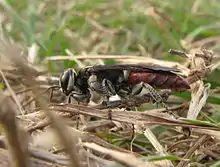Larra (genus)
Wasps in the genus Larra are parasitoids that attack various species of mole crickets. Found throughout the tropics, they have gained prominence as integrated pest management agents.
| Larra | |
|---|---|
 | |
| Larra bicolor | |
| Scientific classification | |
| Kingdom: | |
| Phylum: | |
| Class: | |
| Order: | |
| Family: | |
| Subfamily: | |
| Tribe: | |
| Genus: | Larra Fabricius, 1793 |
| Species | |
|
about 12, see text | |
Lifecycle
Larra wasps feed on nectar as adults. Female wasps hunt adult or late-instar mole crickets and lay their eggs upon them, first temporarily paralyzing them by stinging them on the underside. The larva, upon hatching, gradually consumes the host, eventually killing it. It then pupates in or near the remains. The adults are solitary and do not form colonies. Incubation and development are highly variable in length and dependent upon temperature; in winter, the larvae may enter diapause. Each Larra species preferentially hunts a particular set of prey species, even when related prey is available.
The temporary paralysis of the host is a distinctive feature of the genus. Other related wasps generally paralyze the host permanently and bury it so that the larva can consume it undisturbed.
Larra polita, which is endemic to the Philippines, has been successfully introduced to Hawaii to help control Gryllotalpa orientalis, the oriental mole cricket.[1]
Species
- Larra amplipennis
- Larra analis
- Larra anathema
- Larra betsika
- Larra bicolor
- Larra bulawayoensis
- Larra carbonaria
- Larra godmani
- Larra pacifica
- Larra polita
- Larra polita subspecies luzonensis
- Larra scapteriscica
References
- Mole Cricket Knowledgebase Archived 2010-06-11 at the Wayback Machine
- Larra wasps, mole cricket hunters on the UF / IFAS Featured Creatures Web site
- "ITIS Standard Report Page: Larra". Integrated Taxonomic Information System. Retrieved 2008-12-02.
- "Larra (Genus)". zipcodezoo.com. Retrieved 2008-12-02.
